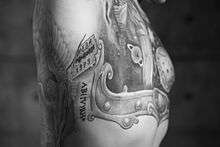Medical tattoo
A medical tattoo is a tattoo used to treat a condition, communicate information, or mark a body location.

Historical uses
A crude practice of corneal tattooing was performed by Galen in 150 CE. He tried to cover leucomatous opacities of the cornea by cauterizing the surface with a heated stilet and applying powdered nutgalls and iron or pulverized pomegranate bark mixed with copper salt; the practice was revived in the 1800s.[1] With the rise of Christianity, tattooing declined and eventually became banned by a papal edict in 787 CE.[2] The practice of corneal tattooing was revived by Louis Von Wecker in the 1870s.[3][4]
To provide medical information
During the Cold War, threats of nuclear warfare led several U.S. states to consider blood type tattooing. Programs were spurred in Chicago, Utah and Indiana based on the premise that if an atomic bomb were to strike, the resulting damage would require extremely large amounts of blood within a short amount of time.[5][6][7][8]
Similar to dog tags, members of the U.S. military may have their vital information tattooed on themselves, usually on the rib cage below the armpit; they are referred to as "meat tags".[9][10][11]
Tattoos have also been used to provide notice to emergency personnel that a person has diabetes mellitus; people with this condition may fall into a diabetic coma and be unable to communicate that information.[12][13]
For radiation treatment
Tattoos have been used as fiducial markers as an aid in guiding radiotherapy.[14] Similarly, Scott Kelly utilized marker tattoos in the positioning of sonogram probes for multiple checks for atherosclerosis while on a long-duration mission on the International Space Station.[15]
Paramedical tattoos
A paramedical tattoo is a cosmetic tattoo applied because of a medical condition or to disguise the results of its treatment.
During breast reconstruction after mastectomy (removal of the breast for treatment of cancer), or breast reduction surgery, tattooing is sometimes used to replace the areola which has been removed during mastectomy, or to fill in areas of pigment loss which may occur during breast reduction performed with a free nipple graft technique.[16] Other uses include simulating the appearance of fingernails and covering scars.[17]
See also
References
- Ziegler, SL (1922). "Multicolor Tattooing of the Cornea". Transactions of the American Ophthalmological Society. 20: 71–87. PMC 1318311. PMID 16692612.
- Levy, J (1979). A short history of tattooing. pp. 851–6.
- Turell, R (1942). Technic of tattooing with mercury sulfide. Ann Surg. pp. 126–30.
- Von Wecker, L (1872). Das Tätowiren der Hornhaut. Arch Augenheilkunde. pp. 84–7.
- "Booklet tells what to do if city is bombed" (7). Chicago Daily Tribune. Dec 7, 1950.
- "Mass tattoo of 200,000 on in Lake County" (1). Chicago Daily Tribune. August 26, 1951.
- Kite, L (August 2, 2006). "Sign of the times". The Herald Journal.
- Wolf, E. K; Laumann, A. E (2008). "The use of blood-type tattoos during the Cold War". Journal of the American Academy of Dermatology. 58 (3): 472–6. doi:10.1016/j.jaad.2007.11.019. PMID 18280343.
- Kristin Wilson Keppler (18 August 2010). "The man who makes sure dead marines get home". BBC News. Retrieved 22 March 2012.
- Katherine Kington (27 February 2012). "Medical tattoos on the rise". WTVM. Retrieved 22 March 2012.
Donny says much like an Army dog tag, the soldiers call them meat tags.
- Reilly, Rick (17 February 2003). "Where Have All the Young Men Gone?". Time. Time Inc. 161 (2–10). Retrieved 22 March 2012.
A lot of 'em are young and scared to be going over," says Rachael Mays of the Sleeping Dragon tattoo parlor. "They come in for their meat tags. You know, dog tags for the skin. Their name, rank, serial number, religion, blood type and gas-mask size. They want 'em in case they're blown in half. Then at least some part of them can come back to their folks.
- Kluger N, Aldasouqi S (May 2012). "A new purpose for tattoos: Medical alert tattoos". Presse Med. 42 (2): 134–7. doi:10.1016/j.lpm.2012.04.009. PMID 22647627.
- Richard S. Irwin; James M. Rippe (2008). Irwin and Rippe's intensive care medicine. Lippincott Williams & Wilkins. pp. 1256–. ISBN 978-0-7817-9153-3. Retrieved 4 December 2012.
- Greer PB, Mortensen TM (1997). "Anterior-posterior treatment localization in pelvic radiotherapy: tattoos or fixed couch-to-isocentre distance". Med Dosim. 22 (1): 43–6. PMID 9136107.
- "Halfway Through a Year in Space: How the Science Gets Done". TIME. Retrieved 26 March 2019.
- Potter S, Barker J, Willoughby L, Perrott E, Cawthorn SJ, Sahu AK (June 2007). "Patient satisfaction and time-saving implications of a nurse-led nipple and areola reconstitution service following breast reconstruction". Breast. 16 (3): 293–6. doi:10.1016/j.breast.2006.12.004. PMID 17241786.
- Anthony, Cara (2020-02-18). "Ink Rx? Welcome To The Camouflaged World Of Paramedical Tattoos". Kaiser Health News. Retrieved 2020-02-20.